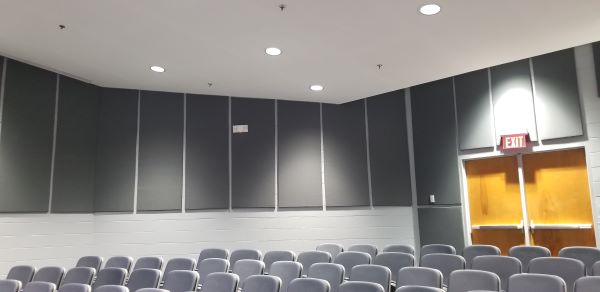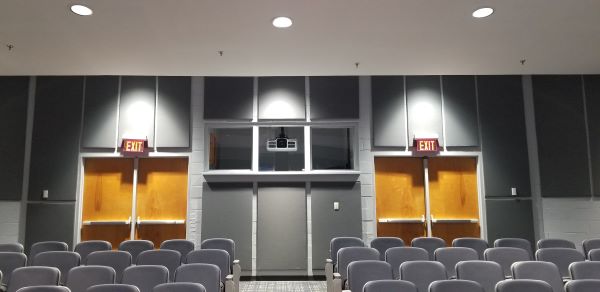Multipurpose university auditoriums often require acoustic panels or some other form of acoustic treatment, especially if the space will be used for classes, speaking events or performances. This is why when designing college auditoriums, architects will typically specify acoustic panels or a stretched fabric wall.
Auditorium Acoustics: 8 Factors to Consider when Designing for Sound
University Auditorium Acoustic Fabric Wall
Commercial Acoustics was contracted by Georgia State University to install acoustic treatment in two of the new campus auditoriums. Each auditorium had stretched fabric wall sections along the back wall, and along the front of the stage. Although acoustic wall panels could have been an option here, a stretched fabric wall was ideal for having the panels match the slope of the ceiling, and for the amount of penetrations that would need to come through the panels.

Over the course of 2 weeks, our team installed fabric wall with a 1″ thick fiberglass core, covered in acoustically transparent fabric. Each segment of the fabric wall was spaced out by about 4″, and although fabric wall is typically for wall-to-wall applications, it allowed our team to easily match the slope of the panels to the slope of the ceiling. Also, since acoustic treatment was required on the front of a curved stage, fabric wall was necessary there as well since both the track and fiberglass can be curved to match the shape of the stage.
Benefits of Stretched Fabric Wall in School Auditoriums
Fortunately, the stretched fabric wall was designed into the auditoriums and the installation could take place before any use of the spaces were needed. Oftentimes when people realize acoustic treatment is required after occupancy of the space, the total cost for treatment increases. Extra costs post-occupancy can include the cost of overnight labor (after classes or performances), and the increased amount of man hours (navigating around auditorium seating).
The target reverb time in multipurpose auditoriums is 1.3 seconds, and should not exceed 1.5 seconds, otherwise it can be difficult to understand any amplified speech in the space. Without the acoustical fabric wall, the reverb time in the auditorium likely would have been too high, as the drywall ceilings and CMU walls would have created too much echo. However, had the auditoriums been designed with an Acoustic Ceiling Tile grid, they could have gone with much less or even no acoustic treatment on the walls.

If your educational auditorium project has reverberation or echo issues, consider specifying Commercial Acoustics’ Ekko Eraser Acoustic Fabric Wall to reduce your reverb time, for am ore acoustically comfortable learning environment.

